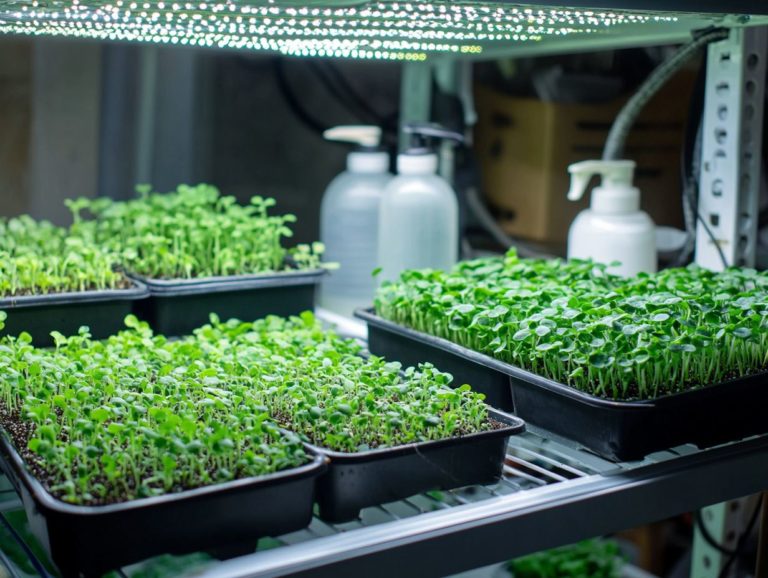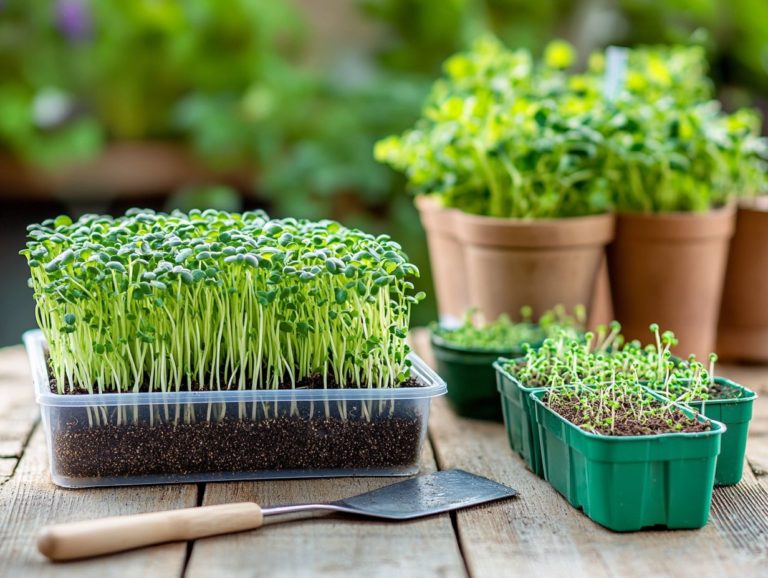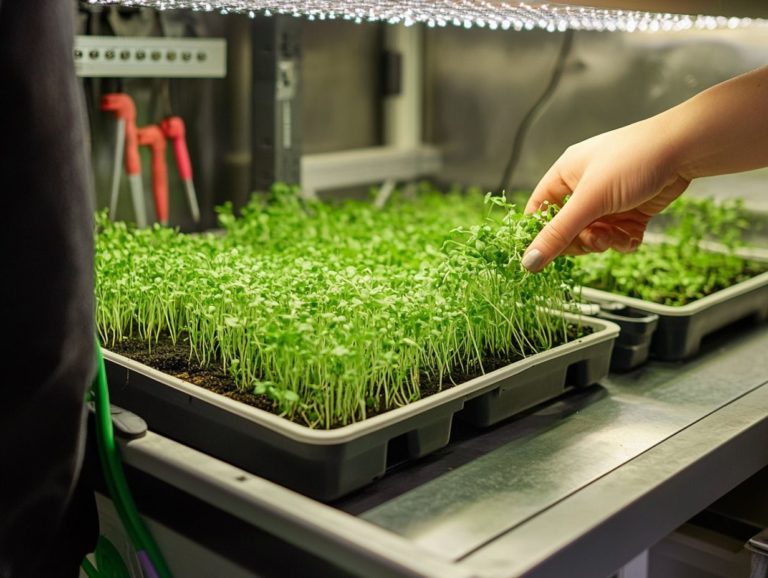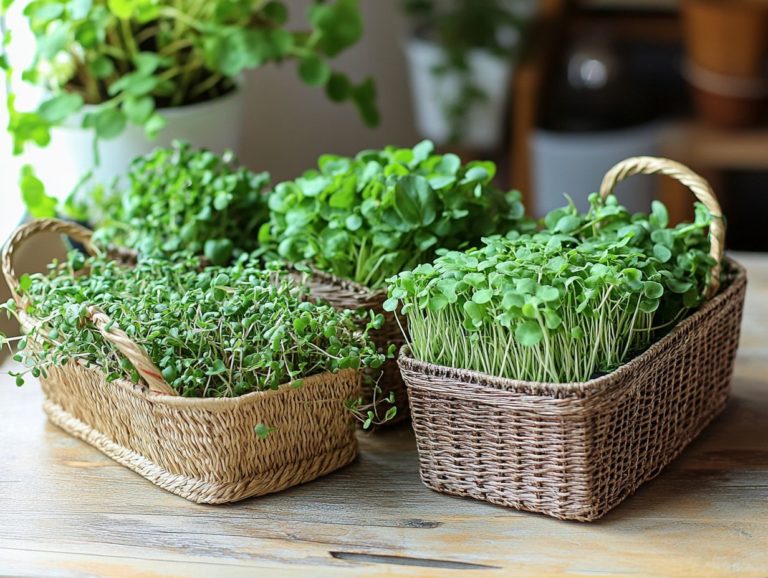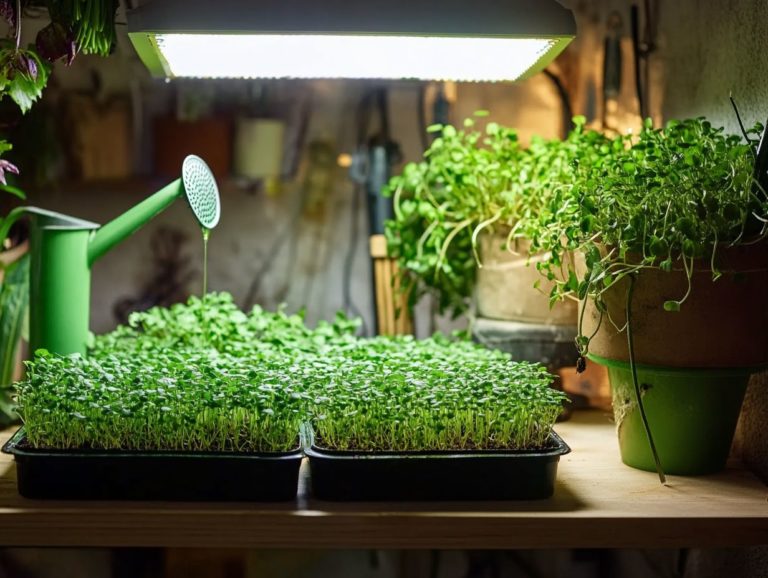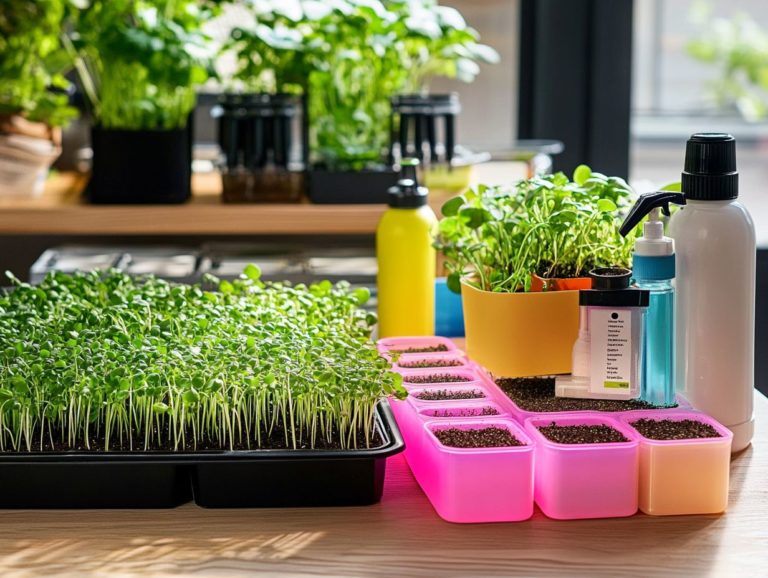Essential Safety Gear for Microgreen Growers
Microgreens are changing the culinary scene! They bring vibrant flavors and amazing health benefits in a tiny package. As vertical farming rises and portable food scales allow for precise measurements, these nutrient-dense greens have revolutionized the culinary landscape.
As you embark on the journey of growing microgreens, be aware that it comes with its own set of challenges and potential hazards. One important consideration is the use of pathogen-free seeds seeds that are free from harmful bacteria or viruses.
Understanding the significance of safety gear is essential for anyone diving into microgreen cultivation. This is particularly important when following food safety regulations. This article will delve into what microgreens are, emphasize the critical safety equipment needed to shield growers from risks, and offer valuable tips for the proper use and maintenance of that gear.
Whether you’re just starting out or are a seasoned grower, prioritizing your safety while nurturing these delicate plants is absolutely crucial. To ensure success, consider investing in must-have equipment for microgreen cultivation.
Contents
- Key Takeaways:
- What are Microgreens?
- Why Safety Gear is Important for Microgreen Growers
- Essential Safety Gear for Microgreen Growers
- Tips for Proper Use and Maintenance of Safety Gear
- Frequently Asked Questions
- What is essential safety gear for microgreen growers?
- Why do I need safety gear for growing microgreens?
- Do I need to wear gloves when handling microgreens?
- What type of face mask is best for microgreen growers?
- Is it necessary to wear protective eyewear when growing microgreens?
- Can I use regular gardening gloves for growing microgreens?
Key Takeaways:
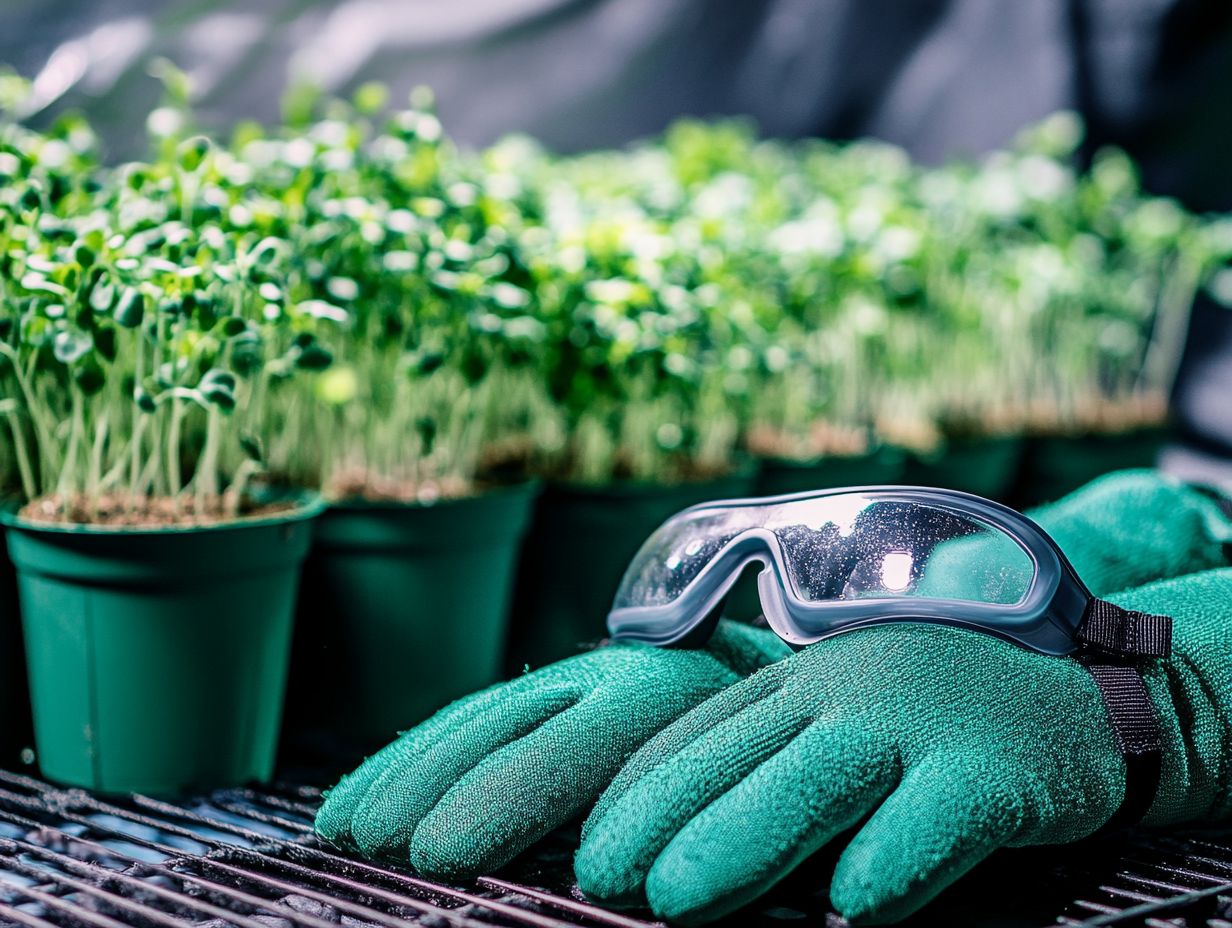
- Wear protective clothing while working with microgreens to prevent contact with potential hazards.
- Use eye and hand protection to avoid injuries and contamination while handling microgreens.
- Properly maintain safety gear by handling and storing it correctly, and following cleaning and replacement guidelines.
What are Microgreens?
Microgreens are young, edible plants that you should consider incorporating into your meals, such as radish, arugula, kale, and mustard, which are commonly grown varieties. Harvested just after the first true leaves emerge, they encompass a delightful array of species, including radish, arugula, kale, and mustard.
These nutrient-dense greens are prized not only for their intense flavors and vibrant colors but also for their impressive nutritional profiles. This makes them a staple in many culinary creations.
As a convenient and sustainable source of nutrition, microgreens are gaining traction among health-conscious consumers and urban gardeners alike.
Definition and Benefits
Microgreens are those young plants you harvest shortly after they sprout. They are bursting with nutrients and flavor, offering a wealth of health benefits.
These petite greens don t just add a splash of color to your meals; they are true powerhouses loaded with vitamins, minerals, and antioxidants that support your overall well-being. For example, broccoli and kale microgreens are incredibly rich in vitamins C and K, which are crucial for your immune function and bone health, respectively.
Utilizing enhanced growth techniques, such as nutrient solutions and premium soil, is essential for maximizing their nutritional profiles. This ensures you get a product that’s as beneficial as it is delicious.
As more people become aware of these advantages, the demand for microgreens is rising, with many actively seeking healthier alternatives in their diets.
Why Safety Gear is Important for Microgreen Growers
Safety gear is essential for you as a microgreen grower, ensuring that you comply with food safety regulations while minimizing health risks and maintaining high sanitation practices throughout your cultivation process.
As the industry faces growing regulation under the Food Safety Modernization Act (FSMA) and Produce Safety Rule, grasping the significance of the right gear becomes crucial for guaranteeing safe, pathogen-free microgreen production. This includes knowing how to properly store microgreen supplies to maintain quality.
Potential Hazards in Microgreen Growing
Microgreen growing comes with its share of potential hazards, particularly the risk of contamination from pathogens like Salmonella and E. coli. This makes food safety a critical priority for you as a grower.
To effectively mitigate these risks, it’s essential for you to prioritize the use of pathogen-free seeds. These seeds play a vital role in preventing any outbreaks that could jeopardize both your produce and your customers’ health.
Maintaining rigorous cleaning and sanitizing protocols in your growing environment is equally important. By regularly disinfecting your tools, surfaces, and equipment, you can significantly diminish the chances of cross-contamination.
By understanding these specific hazards and adhering to stringent safety measures, you ensure that your microgreens remain a healthy and safe choice for consumers. This ultimately enhances their trust in your product.
Ready to dive into the world of microgreens? Gather your gear and start your journey today!
Essential Safety Gear for Microgreen Growers
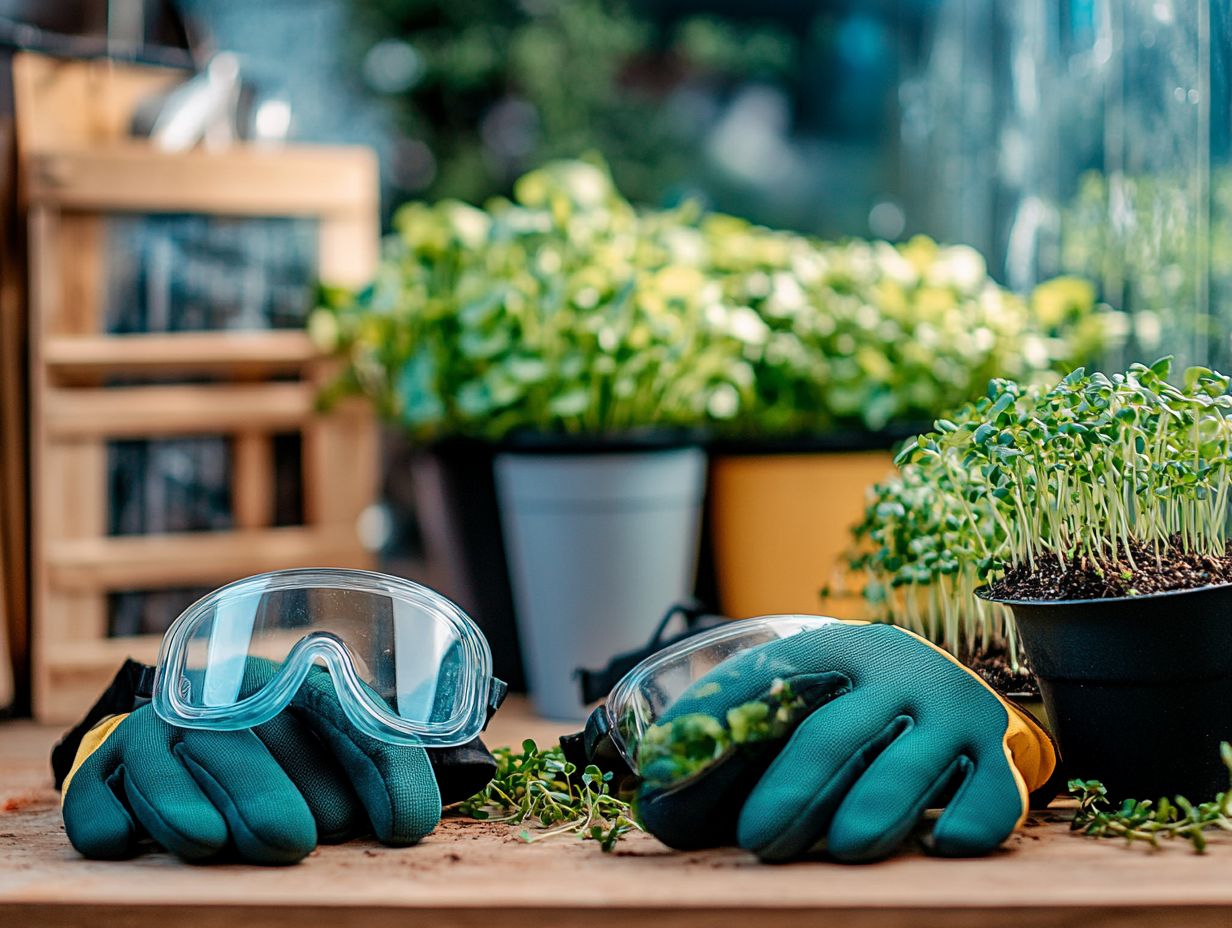
Equipping yourself as a microgreen grower with essential safety gear like sterilized gloves, protective clothing, and appropriate cleaning supplies is crucial for maintaining a safe and efficient growing environment. Prioritizing these safety measures enhances your productivity and safeguards your health as you cultivate your greens.
Protective Clothing
Protective clothing is an important part of safety gear for you as a microgreen grower. It offers protection against contaminants while ensuring you meet food safety standards.
There are various options available, from breathable coveralls that reduce pesticide exposure to specialized gloves designed to prevent bacteria transfer. Each garment helps maintain a clean environment, whether through moisture-wicking fabrics that keep your skin dry or high-visibility vests that enhance safety in busy operations. For those interested in indoor gardening, exploring microgreen growing equipment can also be beneficial.
Consider aprons with pockets; they allow you to keep essential tools close at hand, promoting efficient sanitation practices. Embracing these customized garments enables you to cultivate your microgreens in a cleaner and safer manner.
Eye and Hand Protection
Eye and hand protection are essential for mitigating the risks of harmful substance exposure while ensuring adherence to food safety protocols.
By wearing the right gear like sterilized gloves and goggles, you create a safer working environment. Gloves protect your hands from irritants in the soil and plant material while preventing pathogen transfer. For those interested in essential tools for microgreen growing success, having the proper equipment is crucial.
Goggles serve as a barrier against dust and splashes, safeguarding your vision and eye health during the cultivation process. Together, these precautions enhance your overall safety and hygiene, promoting healthier microgreens for your consumers and instilling confidence in your cultivation practices. For those looking to improve their techniques, following essential tips for growing microgreens at home can be invaluable.
Breathe Easy: Protect Your Lungs
Respiratory protection is a vital component of safety gear for you as a microgreen grower. It shields you against airborne contaminants that can arise during growing.
This protection comes in forms like disposable masks, reusable respirators, and specialized filters for specific pollutants. Equipping yourself with the right respiratory gear is about personal safety and fostering a clean and healthy environment for your microgreens. For more information, check out the ultimate guide to microgreen supplies.
Maintaining good sanitation practices and following food safety standards are paramount. Without proper respiratory protection, the risk of contaminating your crops with harmful particles increases. For effective techniques, consider harvesting microgreens: tools of the trade to make respiratory safety a priority, boost your productivity, and protect your crops.
Other Necessary Gear
Along with your protective clothing, you should also consider essential gear like harvesting tools, cleaning supplies, dehumidifiers, and pH testers to maintain a safe and productive growing environment.
These tools are crucial for ensuring your cultivation process is a success. For example, harvesting tools help you cut microgreens carefully without damaging the plants, allowing for a high-quality yield.
Cleaning supplies are necessary to eliminate contaminants that could harm your crops and yourself, fostering a healthier ecosystem.
Dehumidifiers regulate moisture levels, preventing mold, and ensuring that your microgreens thrive. Meanwhile, pH testers are devices that measure the acidity or alkalinity in the soil, allowing you to tailor your practices and optimize crop health.
Incorporating this gear into your routine elevates your safety measures and enhances the quality of your harvests. For those interested in growing microgreens, having the right tools is crucial, so don’t wait until it’s too late! Equip yourself with the essential tools for harvesting microgreens today.
Tips for Proper Use and Maintenance of Safety Gear
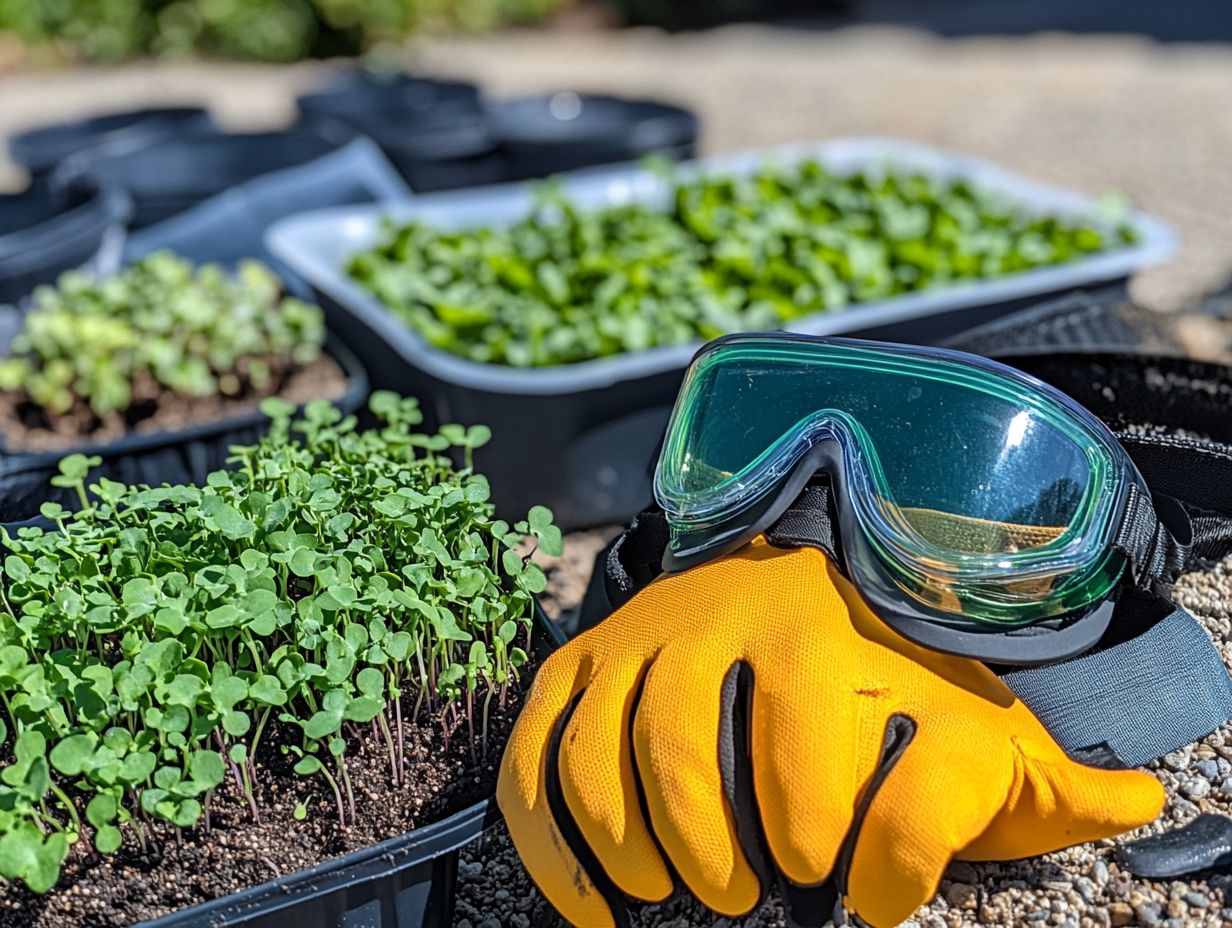
The proper use and diligent maintenance of safety gear are crucial for you as a microgreen grower. By adhering to these practices, you not only meet food safety standards but also uphold the highest cleaning practices throughout your cultivation process.
Proper Handling and Storage
Proper handling and storage of safety gear are vital. This includes cleaning supplies and sterilized gloves to ensure long-term effectiveness and compliance with food safety protocols.
Store your gloves in a cool, dry place to keep them in top shape! Regularly check expiration dates. This step is essential to replace any gloves that have surpassed their prime.
Cleaning supplies must be clearly labeled and kept in a designated area that is easily accessible yet secure from unauthorized access. Routine inspections and cleaning of these areas will help prevent cross-contamination.
By adhering strictly to these practices, you can significantly reduce the risks associated with germs and foster a safer environment.
Cleaning and Replacement Guidelines
Cleaning and replacement guidelines for safety gear are crucial for maintaining effective sanitation practices and ensuring the ongoing safety of your microgreen crops.
By regularly updating and servicing this equipment, you prevent cross-contamination and align with stringent food safety regulations. It is essential for you and your team to adopt a cleaning schedule after each use to eliminate any potential soil or pathogen residue.
Routine inspections of safety gear such as gloves, masks, and aprons for signs of wear are important. Replace them promptly to maintain optimal protection. Following these timelines and protocols helps cultivate a healthier growing environment and consistently produce high-quality microgreens that meet safety standards.
Frequently Asked Questions
What is essential safety gear for microgreen growers?
Essential safety gear includes gloves, aprons, face masks, and protective eyewear.
Why do I need safety gear for growing microgreens?
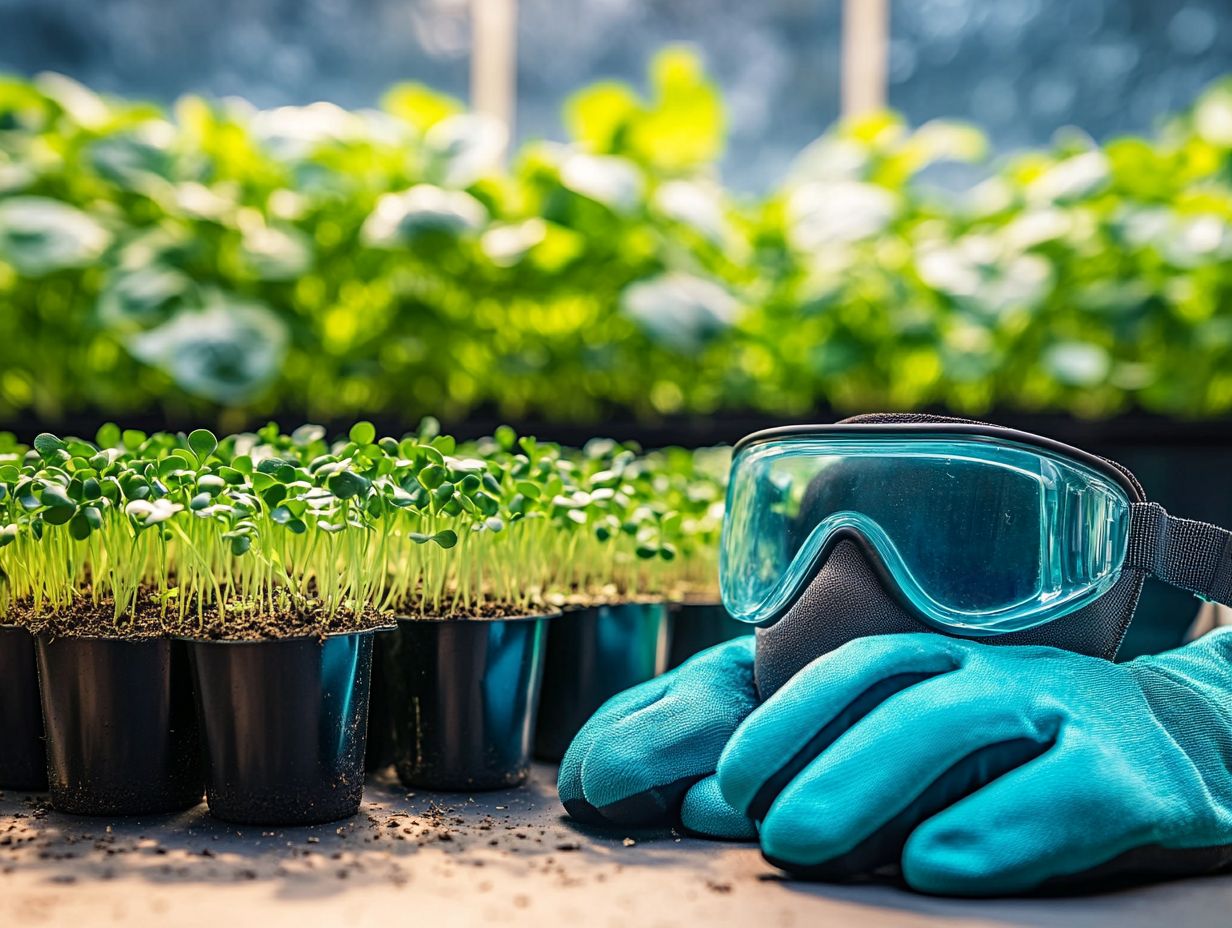
Microgreens can be sensitive to chemicals and pathogens, so it’s important to protect yourself from potential harm while tending to your crops.
Do I need to wear gloves when handling microgreens?
Wearing gloves while handling microgreens can help prevent the spread of germs and protect your hands from potential irritants.
What type of face mask is best for microgreen growers?
A face mask with a N95 rating is recommended as it can filter out small particles and provide protection against potential allergens or harmful substances.
Is it necessary to wear protective eyewear when growing microgreens?
Protective eyewear can shield your eyes from any potential sprays or dust particles while handling microgreens, making it important safety gear.
Can I use regular gardening gloves for growing microgreens?
While regular gardening gloves may offer some protection, it’s best to use gloves specifically designed for handling food to avoid any contamination of your microgreens.

